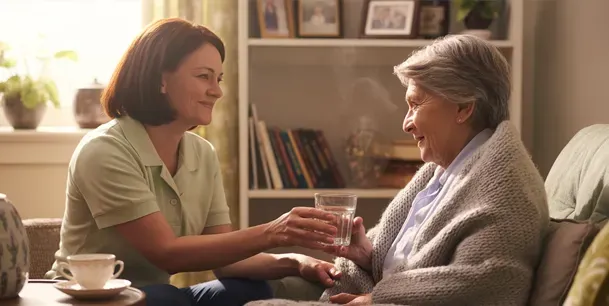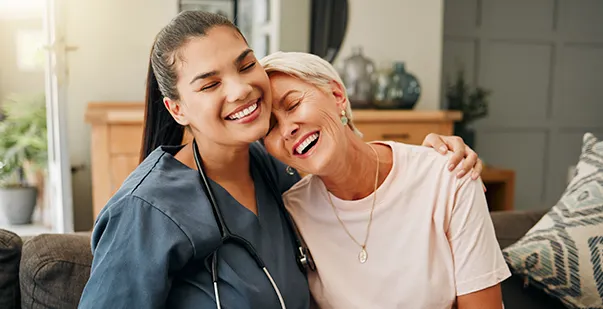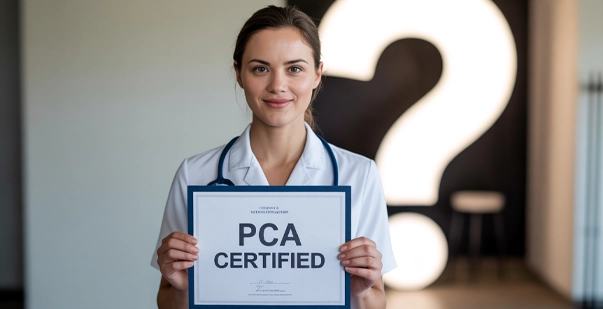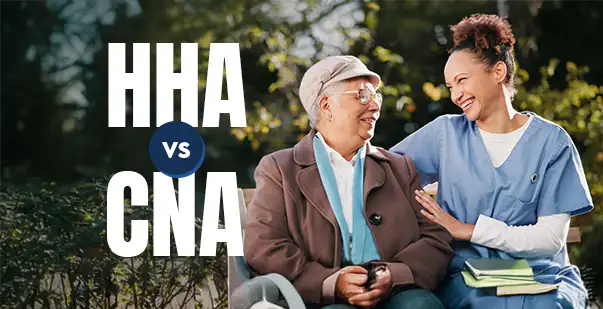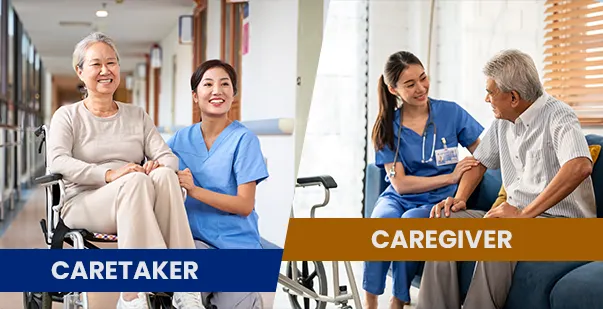Introduction
As people age, they may require assistance with various aspects of daily living, whether physical care or emotional support. According to the WHO, 2 in 3 older adults need long-term support and care from others to perform daily activities. When considering care for them, two terms often come up that are caregiver and caretaker. The words might seem interchangeable at first glance, but a closer look reveals the differences in their daily responsibilities, training, roles, and approaches. So, let’s find out how a caretaker vs caregivers compare to each other and what the differences are in their key roles and responsibilities.
Read More: What is Caregiver Certification and Why is it Important?
What Are The Characteristics of A Caregiver?
A caregiver is a professional or a family member who provides care, support, and assistance to individuals who are unable to perform their day-to-day activities on their own. The reason could be their age, illness, or disability. Thus, as a caregiver, you have to be trained and equipped with skills to provide medical, emotional, and practical support to them. To fulfill your role effectively, you need to have the following key characteristics:
Compassion
Compassion is the most important character you must have when working as a caregiver. You need to understand the situation of those individuals and realize their needs without making them feel vulnerable. Ensure you prioritize their well-being and strive to create a nurturing and supportive environment in which they can lead fulfilling lives.
Patience
As a caregiver, you must be patient. Individuals in your care might have various needs, and it might take them a long time to complete their daily tasks. You should remain calm and understanding in such circumstances and provide them with the necessary support at a pace that suits them.
Flexibility
You should be able to adapt to changing circumstances by understanding the elderly individual’s needs. Their requirements may change over time, and you should be prepared to modify your approach accordingly.
Effective Communication
If you are a caregiver, you should excel in communication with the people you care for, their families, and their healthcare professionals. You should listen attentively and ensure the information is being seamlessly covered.
Read More: How to Become a Certified Caregiver for a Family Member
What Are The Characteristics of A Caretaker?
A caretaker is a person responsible for the maintenance, upkeep, and protection of a person, property, or pet. Unlike the role of a caregiver, a caretaker does not require any training in delivering emotional or medical support. As a caretaker, you may have various responsibilities depending on the context or situation in which you operate. Some common characteristics you should possess as a caretaker include:
Efficiency and Time Management
Caretakers are often efficient in their approach. As a caretaker, you should be able to prioritize tasks such as meal preparation, medication management, and personal care assistance. You should focus on completing tasks in a timely manner and ensuring that every need is effectively met.
Task-oriented
As a caretaker, you should have a task-oriented mindset. A task-oriented mindset helps you organize and handle responsibilities effectively. It ensures the person's daily routine is smooth and structured to improve their quality of life.
Physical Assistance
Caretakers offer physical help with daily activities. This includes bathing, dressing, feeding, and helping with mobility when required. These tasks require patience and care to ensure the individual feels comfortable and supported.
Caretaker Vs Caregiver - A Brief Comparison
In some cases, the roles and responsibilities of a caretaker and caregiver may overlap. However, each role can be tailored to individuals' specific needs. The table below summarises the key differences between a caretaker vs a caregiver.

What Are The Responsibilities of A Caregiver?
When it comes to the responsibilities of a caregiver, the role goes beyond basic and physical care. Tasks might vary depending on the specific individuals you are caring for. Let us explore some common responsibilities you might often undertake:
Personal Care Assistance
As a caregiver, you can provide personal care assistance by helping with activities like bathing, grooming, dressing, and toileting. You also need to assist individuals with mobility by providing adequate support when walking or transferring to and from a wheelchair. Approach these tasks with empathy and respect for the individual’s privacy.
Medication Management
Caregivers are usually trained in providing medical and emotional support. Hence, as a caregiver, you must also ensure that the individual is taking medications as prescribed. This includes following the correct dosage and timing and tracking any potential side effects or interactions. Do not make any changes to the medication regimen without consulting the healthcare professional.
Emotional Support and Companionship
Beyond practical duties, you have to provide emotional support and companionship to the individual in your care. This involves active listening, engaging in conversation, and offering reassurance and comfort. It reduces feelings of loneliness, anxiety, and depression that the individual may experience.
Read More: What Are Residential Assisted Living Facilities?
What Are The Key Responsibilities of a Caretaker?
When it comes to caregiver vs caretaker, caretakers are responsible for the physical care and maintenance of a particular property, location, individual, or pet. They focus on tasks related to daily activities, safety, and security. Their duties are explicitly mentioned in the job description, and they do not perform any extra tasks until asked. Some of the specific responsibilities of a caretaker in detail are as follows:
Household and Daily Living Tasks
As a caretaker, you should assist individuals in care with various household and daily living activities. This includes meal preparation, light housekeeping, grocery shopping, laundry, and running errands. In this way, you can create a comfortable and safe environment for them. Moreover, you need to be flexible and adaptive to adhere to the specific preferences of the individuals you support.
Property Maintenance and Upkeep
As a caretaker, you should ensure that the environment or property you are responsible for remains clean and organized. This includes overseeing day-to-day maintenance operations such as:
You will be responsible for maintaining cleanliness throughout the property, including rooms, common areas, and facilities.
You should perform routine maintenance tasks like checking and repairing equipment, plumbing, and electrical systems to ensure the proper functioning of appliances.
You also have to maintain the outdoor areas of the individual’s property, including lawns, landscaping, and general upkeep of the surroundings.
Safety and Security Responsibilities
Apart from property maintenance, as a caretaker, you also have to ensure the safety and security of the place. Such responsibilities might vary depending on the nature of the individual’s property you are caring for. Below are some common safety duties of a caretaker:
As a caretaker, you will be responsible for monitoring the security of the property, including access control and surveillance systems, and ensuring the safety of the residents.
You should be prepared to handle emergencies and follow appropriate protocols to ensure the safety of individuals on the property.
You need to conduct regular inspections to identify and address safety-related issues. This includes checking for faulty wiring, structural damage, or other potential risks. Make sure to report such safety concerns or potential hazards to the appropriate authorities or management.
Read More: How Much Does Assisted Living Cost?
How to Choose Between Caretaker and Caregiver?
When you want to choose between caretaker and caregiver for your loved one, you need to evaluate the impact of each role on various aspects to make an informed decision. Let us explore some effective tips to make the right choice:
Find the Right Balance
You'll need someone who brings both compassion and proper qualifications to provide elderly support. Thus, you should be aware of caregiver vs caretaker co-dependency to find the right balance to transform the lives of older individuals. When these roles work together, they create a balanced, holistic environment that nurtures both the emotional and practical needs of the elderly.
Instill the Ideal Approach
A strong care strategy should incorporate elements from both caregiver and caretaker roles. Caregivers excel at building emotional connections and providing psychological support, while caretakers focus on hands-on assistance with daily activities and physical needs.
Collaboration and Communication
Clear communication helps you not only choose between these roles but also allows them to work effectively together. The care team should share their observations, challenges, and successes to provide better support. Regular conversations with the elderly person about their needs and preferences will help create a care plan that works best for them.
Building a Meaningful Support System!
Success in elderly care doesn't depend on choosing just one approach. The best support systems often blend elements of both caregiving and caretaking to meet all of a senior's needs. Whether you choose a caregiver, a caretaker, or a combination of both, remember to prioritize respect, appreciation, and clear communication. With an understanding of caretaker vs caregiver and their responsibilities, you can evaluate the necessary factors and provide dignified, compassionate support that enhances your loved one's quality of life. Moreover, if you wish to pursue a career in assisted living or help your loved one on your own, you can also consider enrolling in a certification course for caregivers.
References

.webp)
